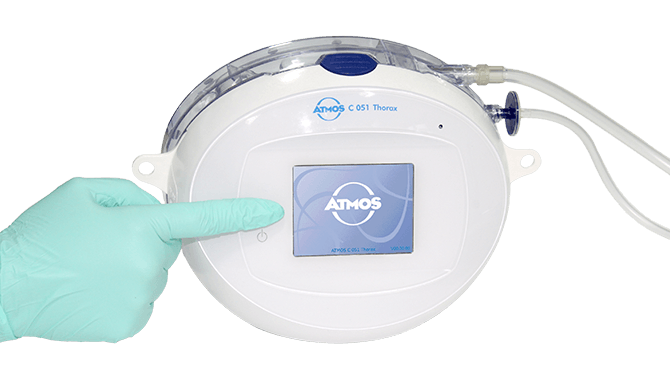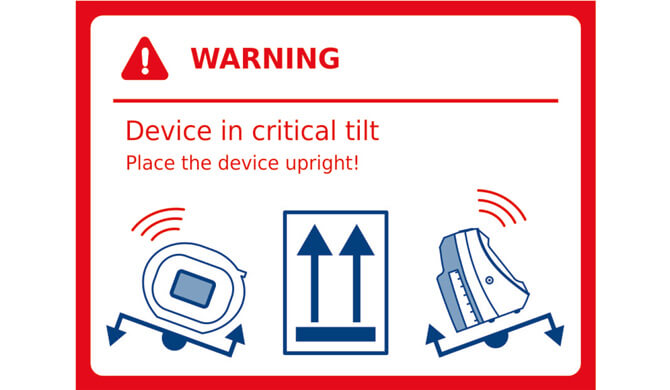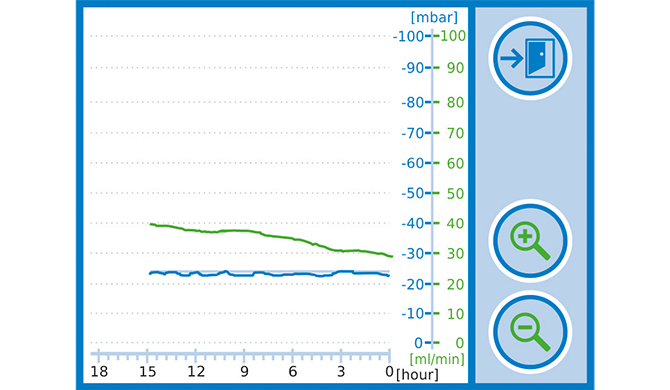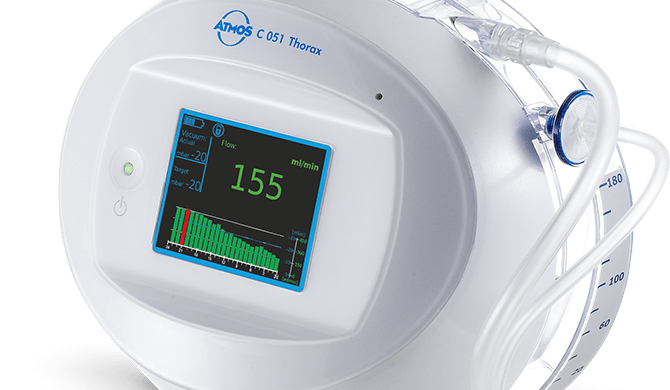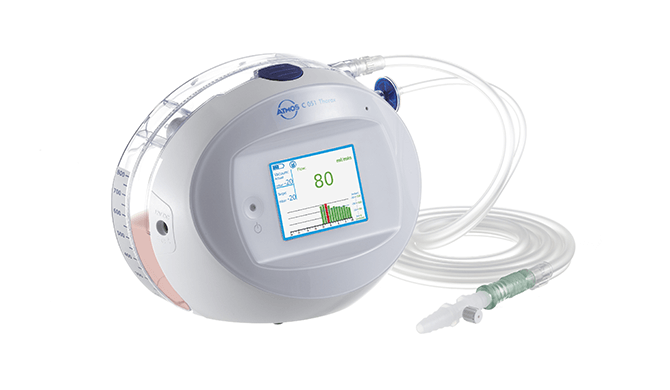ATMOS C 051 Thorax
The solution for maximum mobility
The compact and light ATMOS C 051 Thorax is used for patients with air leaks and pleural effusions as well as for surgical openings of the thorax in cardiothoracic surgery and in pneumology. Thanks to this battery-operated device and its flexible carrying and positioning options, patients can regain unrestricted mobility sooner.


Increased safety for patients and nursing staff
through independent, controlled drainage. The siphon effect is eliminated thanks to precise, patient-side vacuum measurement and the automatic hose rinsing function.
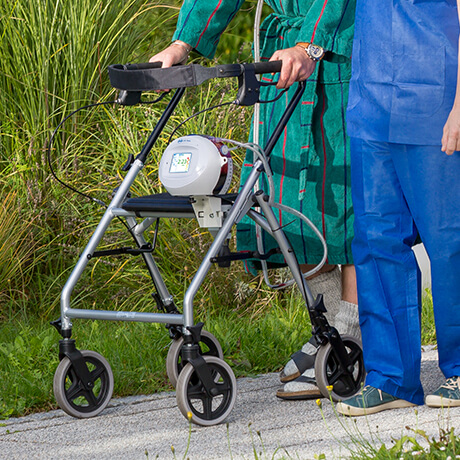
Improved comfort for patients
through early mobilisation due to the portable, mains-independent device. A faster healing process for the patient is promoted as a result.

Greater treatment efficiency
through clinical decisions made on the basis of objective therapy data displayed in real time and in a graph of therapy process over the entire duration of therapy.
Applications
- Hospital / clinic
- Cardiothoracic surgery
- Cardiac surgery
- Emergency medicine
- Intensive care unit
- Operating room / anesthesiology
- Pneumology
- Normal ward
- In-hospital transport
- In-hospital emergencies
Simple, intuitive
operating concept
Reduced care efforts for nursing staff thanks to intuitive, fast operation of the system
Quick and easy system
set-up
Uncomplicated, quick set-up of the system within seconds. This feature brings decisive safety advantages, especially in emergency situations. Saves time in the OR, too.
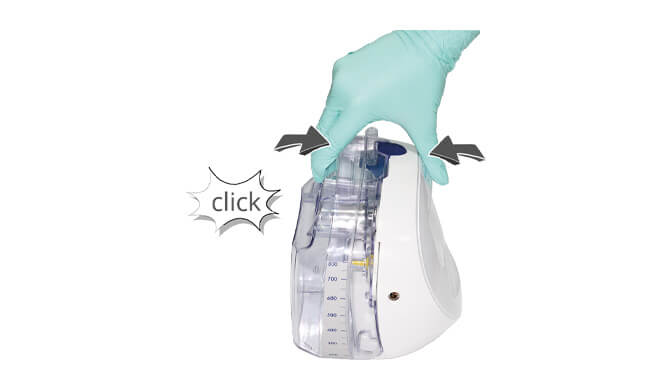
Automatic
warning functions
Fast, automatic, visual and acoustic warning messages assist nursing staff in potentially dangerous situations. This feature reduces time-consuming monitoring tasks for staff.
Objective therapy data
- Rapid evaluation of the clinical situation thanks to immediate recognition of therapy data on the front display
- Safe decisions thanks to objective therapy data displayed in real time, in the trend display over 24 hours, and in a graph showing the course of therapy up to 12 days
Support for
documentation
- Recording, storage, and read-out capability of patient therapy data
- Easy processing of therapy data read-outs is possible in patient documentation, studies, etc.

Transparent
secretion canister
- Clear view of the nature and colour of secretion
- Prevents rapid blockage of the bacterial filter
- Straight hose connection to prevent blockages
Double-lumen
hose system
- Permanent vacuum measurement and regulation:
no siphon effect - Automatic periodic hose rinsing, individually adjustable
- Universal use for all ATMOS Cardiothoracic Drainage Devices
- Flexible use of different connector options
Safe carrying and
positioning options
- Ergonomic carrying handle
- Adjustable, convenient strap
- Flexible, secure placement, e.g. on a standard rail, bed, infusion stand, walking aid
Video
Technical Data
ATMOS C 051 Thorax
Suction capacity
5 ± 0.5 l/min
Vacuum control range
−5 to −100 mbar,
in steps of 1 mbar
Voltage
100–240 V~, 50/60 Hz
Dimensions (H x W x D)
206 x 164 x 95 mm
Weight
1.1 kg (without secretion canister)
1.3 kg (with secretion canister)
Noise level
max. 34 dB(A)
Battery type
Lithium-ion
Battery operation
max. 16 h
Battery charging time
2.5 h
Mobility
Portable.
wearable with shoulder strap
Data management
PDF and Excel report via USB flash drive
Secretion canister
2 chambers
Size: 800 ml
FAQ
The ATMOS C 051 Thorax has a suction capacity of 5 l/min and a secretion canister with 800 ml capacity. This device is ideal for standard patients in the fields of lung surgery, pneumology, general surgery, intensive care, and emergency medicine. The ATMOS S 201 Thorax, on the other hand, has a suction capacity of 18 l/min and a secretion canister volume of 2000 ml. This device is therefore ideally suited for specific patient indications. Above all, the powerful all-rounder is employed in cardiac surgery, but also for lung surgery patients who have large air leaks, such as patients with emphysema or large amounts of viscous fluid (e.g. empyema or chylothorax).
Yes, the hose system from ATMOS can be used flexibly for both digital cardiothoracic drainage devices from ATMOS. This feature helps make storage simple for hospitals and clinics. In addition, the hose system makes it easy to change from the ATMOS S 201 Thorax to the ATMOS C 051 Thorax when the patient's condition improves and to promote mobility.
Besides the set target vacuum, the display also shows the actual vacuum, which is measured at the patient’s end of the hose. In addition, the patient's air leak is shown objectively as flow in ml/min or in l/min for one litre or more. In key lock mode, the flow for at least one hour is also shown by means of bubbles in traffic light colours. If the average flow is below 450 ml/min for one hour, the flow is no longer displayed in bubbles but in a trend display of the last 24 hours.
Air leak is shown continuously in real-time numbers in ml/min or l/min on the display. In addition, the flow for at least 1 hour is visualised by means of bubbles in traffic light colours. If the average flow is below 450 ml/min for 1 hour, the air leak is shown in a trend display over the last 24 hours on the main display. The flow is visualised as an hourly average value in bars over the course of treatment. As soon as the hourly average value of the air leak is less than 150 ml/min, the flow scaling of the trend display becomes even more detailed. Air leaks during the therapy process are also illustrated in the graphs. The long-time display shows therapy data for up to 12 days, and certain time segments, for example, can be viewed individually using the zoom functions. The graphic short-time display can also visualise tests that can provide an indicator for a blocked thoracic catheter or for making the decision whether to remove the catheter.
With the ATMOS S 201 Thorax, the air leak can also be visualised conventionally by means of the optional water lock in the 2000 ml secretion canister.
Yes, visual and acoustic warning messages indicate the reasons for errors and show information on how to remedy them on the display. This feature reduces time-consuming monitoring tasks for nursing staff.
The automatic hose-rinsing function uses air, not liquid. A valve located inside the device directly at the connection for the measuring and rinsing hose opens and pushes air through the measuring and rinsing hose to the patient’s end of the hose. Due to the applied suction, the air is automatically diverted into the secretion hose, and the secretion, blood coagula, etc. in the hose are automatically flushed into the secretion canister. This makes milking obsolete for nursing staff, and the dangerous siphon effect cannot occur. On default settings, the hose is rinsed every 3 minutes.
The hose-rinsing period can be adjusted between 1 and 20 minutes. Immediately following an operation, especially after cardiac surgery, it may be advisable to rinse the hose more frequently (e.g. 1 minute) to prevent the formation of coagula/blockages in the catheter.
Downloads
Accessories

Secretion canister
800 ml

Hose system

Carrying handle

Universal bracket

Support for the standard rail

Disposable strap
Contact


